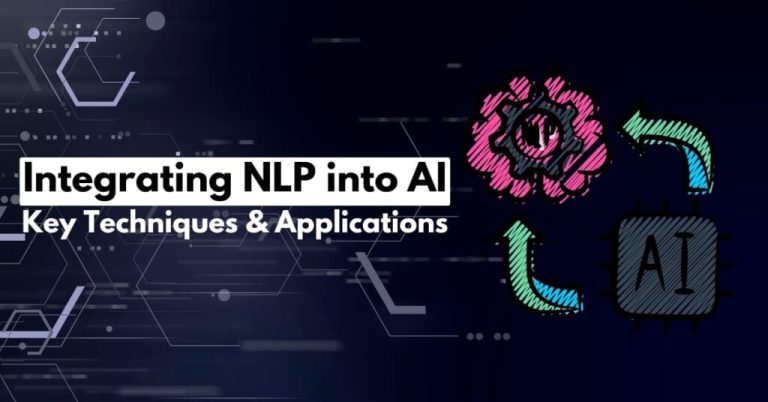Natural Language Processing (NLP) enables AI systems to process and interpret human language, making interactions more seamless and intelligent. It allows AI to analyze text, recognize speech, translate languages, and extract meaningful insights from unstructured data. Businesses use NLP to enhance customer support, improve search engines, and automate workflows.
AI projects that integrate NLP can handle vast amounts of text data efficiently. Chatbots use NLP to understand and respond to customer queries, while sentiment analysis tools evaluate opinions in social media and customer reviews. Automated transcription services convert speech into text, making content more accessible. These applications show how NLP simplifies complex tasks and improves decision-making.
To implement NLP in an AI project, a structured approach is essential. The process involves selecting the right use case, gathering and preparing data, training models, and integrating them into real-world applications. Performance evaluation and continuous improvements ensure accuracy and relevance over time.
A well-executed NLP strategy helps businesses unlock the full potential of AI-driven solutions. With the right techniques and tools, NLP can transform how AI understands and interacts with language, leading to smarter and more efficient applications. The next sections will cover the step-by-step process of using NLP in AI projects.
Identifying the Right Use Case for NLP
NLP plays a crucial role in AI projects, but its success depends on choosing the right application. Businesses must first define what they want to achieve with NLP, whether it’s automating processes, improving user interactions, or extracting insights from data. Identifying a clear use case ensures that resources are allocated effectively and that the AI model delivers measurable benefits.
Some of the most common NLP applications include:
- Chatbots and Virtual Assistants process user queries, provide responses, and improve customer support efficiency.
- Sentiment Analysis evaluates customer feedback, social media discussions, and reviews to gauge public opinion.
- Text Summarization condenses lengthy documents, making information more accessible and easier to digest.
- Machine Translation breaks language barriers by enabling AI-driven translation services.
- Speech Recognition converts spoken words into text, enhancing accessibility and transcription services.
- Named Entity Recognition (NER) identifies specific names, places, or organizations within text, improving data classification.
Selecting the right use case depends on the type of data available and the business goal. For example, an e-commerce business may use NLP to personalize product recommendations, while a financial institution may leverage it to detect fraudulent transactions through text analysis.
A well-defined use case sets the foundation for a successful NLP-driven AI project. Once the objective is clear, the next step is choosing the right tools and technologies for implementation.
Selecting the Right NLP Tools and Technologies fo AI Project Development
NLP development relies on a combination of programming languages, pre-built frameworks, and cloud-based services. The choice of tools depends on factors such as scalability, complexity, and real-time processing needs.
NLP Libraries and Frameworks
- NLTK (Natural Language Toolkit) is useful for academic research and small-scale NLP applications.
- spaCy is designed for production-ready NLP with fast processing speeds and pre-trained models.
- Hugging Face Transformers provides state-of-the-art deep learning models such as BERT, GPT, and T5.
- Stanford NLP offers linguistic analysis for applications requiring deep syntactic and semantic parsing.
- Gensim specializes in topic modeling and document similarity analysis.
Cloud-Based NLP Services
- Google Cloud Natural Language API provides entity recognition, sentiment analysis, and syntax parsing.
- AWS Comprehend supports language detection, key phrase extraction, and topic modeling.
- Microsoft Azure Text Analytics enables businesses to analyze text data and extract actionable insights.
Choosing between local NLP frameworks and cloud-based APIs depends on project requirements. Businesses handling sensitive data may prefer on-premise NLP solutions, while cloud-based services offer flexibility and scalability for real-time applications.
Once the tools are selected, the next step is preparing and preprocessing data to ensure accurate model performance.
Preparing and Preprocessing Data for NLP
NLP models rely on well-structured data to deliver accurate results. Raw text data often contains inconsistencies, unnecessary characters, and irrelevant information. Proper data preparation ensures that the model can interpret language effectively.
Data Collection
The first step is gathering relevant text data based on the NLP use case. Businesses can collect data from various sources, including:
- Customer reviews, emails, and support tickets for sentiment analysis and chatbots.
- News articles, research papers, and reports for summarization and text classification.
- Audio recordings and transcripts for speech recognition models.
Data must be diverse and representative to avoid biases and improve model generalization. If high-quality datasets are unavailable, synthetic data generation techniques can help.
Text Preprocessing
Once the data is collected, it must be cleaned and structured. Key preprocessing steps include:
- Tokenization breaks text into words or phrases, making it easier for the model to process.
- Lowercasing standardizes text by converting all characters to lowercase, reducing inconsistencies.
- Removing stop words eliminates common words like “the,” “is,” and “and” that do not add meaning.
- Punctuation and special character removal ensures that unnecessary symbols do not interfere with analysis.
- Stemming and lemmatization reduce words to their root forms, helping the model recognize variations of the same word.
Handling Unstructured Data
Many NLP applications work with unstructured data, requiring additional processing techniques:
- Named Entity Recognition (NER) helps identify and categorize important terms, such as names, locations, and organizations.
- Part-of-Speech (POS) tagging assigns grammatical roles to words, improving linguistic understanding.
- Text normalization corrects typos, expands abbreviations, and ensures consistency.
Proper data preprocessing enhances model accuracy and efficiency. After data is cleaned and structured, the next step is selecting and training an NLP model.
Training and Implementing NLP Models for AI Projects
Training an NLP model involves choosing the right algorithm, optimizing performance, and integrating the model into an AI system. Businesses can either develop custom models from scratch or fine-tune pre-trained models.
Choosing the Right NLP Model
Different NLP tasks require different models:
- Rule-based models work best for keyword extraction and structured data analysis.
- Traditional machine learning models such as Naïve Bayes and Support Vector Machines (SVM) are effective for text classification.
- Deep learning models like Transformers, BERT, and GPT handle complex NLP tasks, including language generation and semantic analysis.
Model Training
Training involves feeding the model with preprocessed text data and optimizing its parameters. The process includes:
- Splitting data into training and validation sets to measure accuracy.
- Using embeddings like Word2Vec, FastText, or contextual embeddings from BERT for better word representation.
- Applying fine-tuning techniques on pre-trained models to enhance task-specific performance.
Model Optimization
To improve accuracy, models undergo continuous refinement through:
- Hyperparameter tuning to adjust learning rates and model complexity.
- Regularization techniques to prevent overfitting.
- Data augmentation to increase dataset diversity and improve model robustness.
Once trained and optimized, the model is ready for integration into an AI system. The next step involves deploying NLP models for real-world applications.
Evaluating NLP Model Performance
Once an NLP model is trained, its performance must be evaluated to ensure accuracy and effectiveness. A poorly performing model can lead to misinterpretations, incorrect predictions, or biased results. Performance evaluation helps identify areas for improvement before deployment.
Key Performance Metrics
Different NLP tasks require different evaluation metrics. Commonly used metrics include:
- Accuracy measures the proportion of correct predictions in classification tasks.
- Precision calculates how many positive predictions were actually correct.
- Recall determines how well the model identifies all relevant instances.
- F1-score balances precision and recall, especially useful for imbalanced datasets.
- Perplexity evaluates language models by measuring how well they predict a sequence of words.
- BLEU (Bilingual Evaluation Understudy) assesses machine translation accuracy by comparing outputs to human translations.
Addressing Model Limitations
Even well-trained models have weaknesses. Some common challenges include:
- Overfitting, where the model performs well on training data but poorly on real-world text.
- Bias and fairness issues, especially when training data lacks diversity.
- Poor generalization, where the model struggles with unfamiliar words or contexts.
Techniques like cross-validation, data augmentation, and fairness testing help mitigate these issues. A well-evaluated model is more reliable and ready for deployment in AI applications.
Deploying NLP Models in AI Projects
After evaluation, the model is integrated into an AI system for real-world use. Deployment involves making the model accessible for applications like chatbots, search engines, and text analysis tools.
Integration into Applications
NLP models can be deployed in various ways:
- Cloud-based APIs allow businesses to use pre-trained models without requiring extensive computational resources.
- On-premise deployment ensures greater control over data security and customization.
- Embedded AI models run directly within software applications, enabling offline functionality.
Handling Scalability and Real-Time Processing
Deployed NLP models must handle high volumes of text data efficiently. Strategies to improve scalability include:
- Using microservices architecture to separate NLP tasks into independent, scalable services.
- Optimizing inference speed to reduce latency in applications like voice assistants and customer support bots.
- Implementing caching mechanisms to avoid redundant computations and speed up response times.
Continuous Monitoring and Improvement
NLP models require ongoing monitoring to maintain accuracy. Feedback loops and user interactions help refine the model over time. Businesses should regularly update models with new data to adapt to evolving language patterns and emerging trends.
With proper deployment strategies, NLP models enhance AI systems and improve user experiences. The next step involves best practices to maximize their effectiveness.
Best Practices for NLP Implementation in AI Development
Implementing NLP in AI projects requires careful planning and continuous improvement. Following best practices ensures better accuracy, efficiency, and long-term success.
Ensuring High-Quality Training Data
NLP models rely on data for learning and decision-making. High-quality datasets improve model performance and reduce biases. Steps to maintain data quality include:
- Using diverse data sources to ensure models can handle different linguistic styles and variations.
- Removing biased or misleading text to prevent unintended discrimination in outputs.
- Regularly updating datasets to keep the model relevant and aligned with evolving language trends.
Optimizing Model Performance
Fine-tuning models improves efficiency and accuracy. Techniques for optimization include:
- Transfer learning to enhance performance by adapting pre-trained models to specific tasks.
- Hyperparameter tuning to find the best settings for training and inference.
- Model compression techniques to reduce computational load without sacrificing accuracy.
Handling Multilingual and Domain-Specific Challenges
NLP models must handle different languages and industry-specific terminology. Solutions include:
- Leveraging multilingual models like mBERT or XLM-R for language processing beyond English.
- Training domain-specific models for industries like healthcare, finance, and legal services.
- Customizing embeddings to include terminology relevant to the project’s focus area.
Ethical Considerations and Bias Mitigation
Bias in NLP models can lead to inaccurate or unfair predictions. Steps to minimize bias include:
- Conducting fairness audits to detect biases in model outputs.
- Training models on balanced datasets to avoid over-representing specific perspectives.
- Implementing explainability techniques to make NLP decision-making more transparent.
By following these best practices, businesses can build reliable and responsible NLP-powered AI applications. The final section summarizes the key takeaways from this guide.
Conclusion
NLP enhances AI systems by enabling them to understand and process human language effectively. From automating customer interactions to analyzing large volumes of text data, NLP plays a key role in building intelligent solutions.
Successful implementation requires a structured approach, starting with defining the right use case, selecting appropriate tools, and ensuring high-quality data. Proper training, evaluation, and deployment strategies help optimize model performance. Continuous monitoring and improvements keep NLP models relevant and effective.
Top AI development companies leverage NLP to build scalable and efficient AI solutions, enabling businesses to extract insights, automate processes, and improve decision-making. By following best practices, businesses can develop NLP-powered AI systems that drive efficiency and enhance user experiences.




